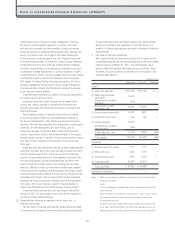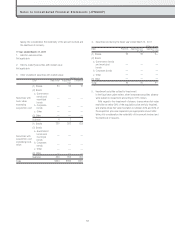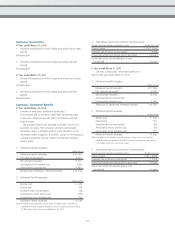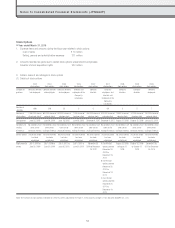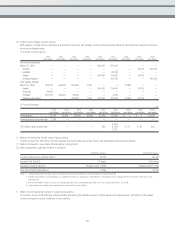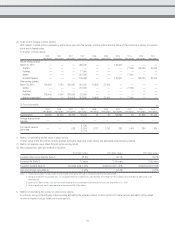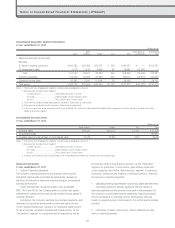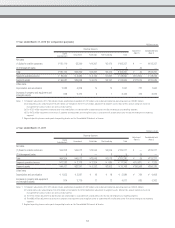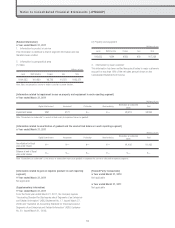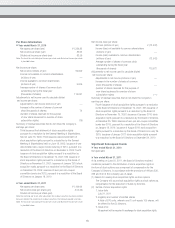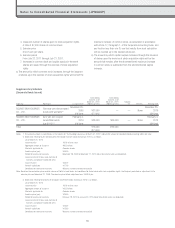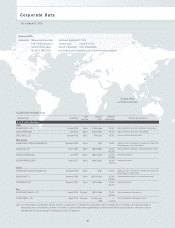Square Enix 2011 Annual Report Download - page 62
Download and view the complete annual report
Please find page 62 of the 2011 Square Enix annual report below. You can navigate through the pages in the report by either clicking on the pages listed below, or by using the keyword search tool below to find specific information within the annual report.
Notes to Consolidated Financial Statements (JPNGAAP)
In addition, by integrating the business operated by TAITO
SOFT CORPORATION related to game software for home game
consoles into the games business operated by SQUARE ENIX
CO., LTD., the Group aims to enhance the efficiency and
profitability of these businesses.
2. Outline of the accounting treatment
The transaction was treated as a common control transaction pursuant
to “Accounting Standard for Business Combinations” (Business
Accounting Council, issued on October 31, 2003) and “Implementation
Guidance on Accounting Standard for Business Combinations and
Accounting Standard for Business Divestitures” (Accounting Standards
Board of Japan Guidance No. 10, revised on November 15, 2007).
These transactions, namely the aforementioned absorption-type
company split and absorption-type company merger, have no impact on
the Consolidated Financial Statements.
■ Year ended March 31, 2011
Not applicable
Asset Retirement Obligations
■ Year ended March 31, 2011
Balance Sheet Amount for Asset Retirement Obligations
a) Summary of applicable asset retirement obligations
Asset retirement obligations include the duty of restoration
arising from contractual requirements set forth in real estate
leases for buildings, including offices at the headquarters, as
well as amusement facility arcades.
b) Assumptions used in calculating applicable asset retirement
obligations
Asset retirement obligations on buildings, including offices at
the headquarters, are based on estimated useful life, generally
ranging between 10 and 24 years, and a discount rate generally
set between 1.300% and 2.240%.
For amusement facility arcades, asset retirement obligations
are based on an estimated useful life of 10 years—the average
operating period for arcades that have been closed—and a
discount rate between 0.955% and 1.355%.
c) Changes to aggregate asset retirement obligations applicable to
the fiscal year ended March 31, 2011
Millions of yen
Beginning balance (See note) ¥649
Increase due to procurement of property and equipment 1
Accretion expense 8
Decrease due to fulfillment of asset retirement obligations (9)
Other 71
Ending balance ¥721
Note: From the fiscal year ended March 31, 2011, the Group applies “Accounting
Standard for Asset Retirement Obligations” (ASBJ Statement No. 18, issued on
March 31, 2008) and “Guidance on Accounting Standard for Asset Retirement
Obligations” (ASBJ Guidance No. 21, issued on March 31, 2008). As a result,
the Group recognized asset retirement obligations at beginning of the fiscal year
ended March 31, 2011.
6. Estimated impact on the Consolidated Statements of Income in this
fiscal year calculated based on the assumption that the business
combination was completed on the first day of the fiscal year
Millions of yen
Net sales ¥ 0
Recurring loss 447
Net loss 447
These estimates were not subject to audit certification.
Common control transactions
1. Outline of the business combination
(1) Name of the company acquired and business operations subject
to the business combination
In February 2010, the Company’s wholly owned subsidiary
TAITO CORPORATION (hereinafter “the splitting company”)
transferred all its rights and obligations relating to the amusement
business to ES1 CORPORATION (hereinafter “the succeeding
company”), also a wholly owned subsidiary of the Company, in
an absorption-type company split. Simultaneously, the corporate
name of the splitting company was changed to TAITO SOFT
CORPORATION and the corporate name of the succeeding
company was changed to TAITO CORPORATION.
Prior to the aforementioned absorption-type company split,
SPC-NO. 1 CO., LTD. (“SPC1”), the succeeding company’s
100% parent company and a wholly owned subsidiary of the
Company, and the succeeding company were merged by way of
an absorption-type merger, with SPC1 being the absorbed entity
and the succeeding company being the surviving entity.
Subsequently, in March 2010, TAITO SOFT CORPORATION
was subject to an absorption-type company merger. The
Company’s wholly owned subsidiary SQUARE ENIX CO., LTD., is
the surviving entity.
(2) Legal form of the business combination
An absorption-type company split in which TAITO CORPORATION
is the splitting company and ES1 CORPORATION is the succeeding
company. In addition, an absorption-type company merger in
which TAITO SOFT CORPORATION is the extinguished entity and
SQUARE ENIX CO., LTD., is the surviving entity.
(3) Name of the post-combination company
Absorption-type company split: TAITO CORPORATION
The corporate name of the splitting company was changed
to TAITO SOFT CORPORATION and the corporate name of the
surviving company was changed to TAITO CORPORATION.
Absorption-type company merger: SQUARE ENIX CO., LTD.
(4) Outline of the transaction including purpose of the transaction
The purpose of the transaction is to aggregate the Group’s
business units responsible for operating its amusement-related
businesses, and hence improve efficiency and profitability
by transferring the amusement business from TAITO SOFT
CORPORATION as the splitting company to ES1 as the succeeding
company, which has operated arcade facilities prior to the
transaction.
60


